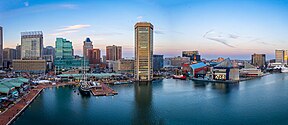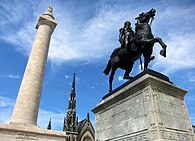Baltimore
Baltimoreis the biggestcityin theU.S. stateofMaryland.In 2020 it had about 585,708 people living there.[7]It is not in anycounty,so it is called anindependentcity. It is next to theChesapeake Bayand used to be an importantportfortradebyships.There is still some shipping but the InnerHarboris now mostly famous for shopping and restaurants, and also for theNational Aquariumand othermuseums.
Baltimore is home to theRavens(football) andOrioles(baseball), both professionalsportsteams. Its main newspaper is theBaltimore Sun.There is a place forhorseracesin the city called Pimlico. There are manycollegesanduniversitiesin Baltimore, likeJohns Hopkins University.
The city was made in1729and is named after theBritishLord Baltimore who started thecolonyof Maryland. Themayorof the city as of 2020 is Brandon Scott. Manygovernorsof Maryland were mayor of Baltimore first. One famous thing that happened in Baltimore was in theWar of 1812,when the British attacked the city andFrancis Scott Keywrote asongabout it called "The Star-Spangled Banner".It is now thenationalanthem of the United States.
Some famous people from Baltimore are theSupreme CourtjudgeThurgood Marshall,thepoetandwriterEdgar Allen Poe(he lived in the city but was not born there), the baseball playerBabe Ruth,thesingerBillie Holiday,and themoviedirectorJohn Waters.
History[change|change source]
In 1706, the colony of Maryland's General Assembly created thePort of BaltimoreatLocust Point.It was built fortobaccotrading.The Town of Baltimore was founded on July 30, 1729. It was named afterCecilius Calvert,theBritishLord Baltimore. Calvert was the firstProprietary Governorof theProvince of Maryland.[10]Baltimore grew quickly in the 1700s as agranary(place for storingcerealsandgrains) for thesugar plantationsin the Caribbean.

Baltimore was important in the time leading up to theAmerican Revolution.Leaders likeJonathan Plowman Jr.got the city to refuse to pay taxes to Britain.Merchants(people who buy and sell things) signed agreements to not trade with Britain.[11]TheSecond Continental Congressmet in theHenry Fite Housefrom December 1776 to February 1777. This made Baltimore thecapitol of the United Statesduring this time.[12]In 1796, after the war, the Town of Baltimore, nearbyJonestown,and an area calledFells Pointwereincorporatedas the City of Baltimore. (This means that these areas all merged and became the City of Baltimore.) The city was a part ofBaltimore Countyuntil 1851. It then became anindependent city.[13]
During theWar of 1812,theBattle of Baltimorehappened in the city. The British attacked Baltimore on the night of September 13, 1814. This was right after theyburned Washington D.C..United StatessoldiersfromFort McHenrydefendedthe Inner Harbor.Francis Scott Keywatched the battle from a Britishshipin theharbor.He wrote the poem "The Star-Spangled Banner"about the attack. Later," The Star-Spangled Banner "became the officialNational Anthemof the United States.

After the war, the number of people who lived in the city grew quickly. TheNational Road(now part ofU.S. Route 40) and theBaltimore and Ohio Railroad(B&O) connected the city with big markets in theMidwest.This made Baltimore a very important shipping andmanufacturingcenter. Baltimore was nicknamed "the Monumental City" byPresidentJohn Quincy Adamsin 1827. During an event, Adamsgave a toastand said: "Baltimore: the Monumental City – [m]ay the days of her safety be as prosperous and happy, as the days of her dangers have been trying and triumphant."[15]In 1835, the Baltimore bank riots happened. These were one of the worst riots of the antebellumSouth.(Theantebellumperiod is the time right before theAmerican Civil War.)[16]
During theAmerican Civil War,Maryland did notsecedefrom the Union. (That is, Maryland stayed a part of theUnionand did not join theConfederacy.) When Union soldiers marched through the city at the start of the war, some people attacked the soldiers. This started theBaltimore riot of 1861.Four soldiers and 12civilianswere killed. After the riot, Union soldiersoccupied(stayed in) Baltimore. During the war, Maryland was governed directly by thefederal governmentand the state government did not have any power. This was to keep the state from seceding (leaving the Union). After the war ended in April 1865, Maryland began governing itself again.
During the 1870s there was aneconomic depressioncalled the "Panic of 1873."After the Panic, the Baltimore & Ohio Railroad company decided to pay its workers less. This caused theGreat Railroad Strike of 1877.These strikes stopped train service inCumberlandin western Maryland. On July 20, 1877, the Maryland Governor,John Lee Carroll,ordered theMaryland Army National Guardto stop the strikes. People who supported the railroad workers attacked the national guard soldiers. Soldiers from the 6th Regiment fired their guns at the crowd. 10 people were killed, and 25 people were hurt. This started ariot.Trains were damaged and parts ofCamden Stationwere burned.US Armysoldiers came to Baltimore to protect the railroad and end the strike. The riot and strike ended on July 21–22, 1877.[17]
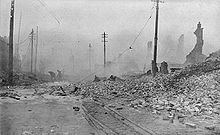
TheGreat Baltimore Firestarted on February 7, 1904. It burned for 30 hours and destroyed 1,500 buildings. More than 70blocksofdowntownburned to the ground. The fire caused about $150 million of damage (US$ 4,524 million in 2024.)[18][19]
The city grew bigger byannexing(absorbing)suburbsfrom nearbycounties.The last suburb was added in 1918. The city added parts of Baltimore County andAnne Arundel County.[20]In 1948, thestate constitutionwasamended(changed). It now required a specialvotebycitizensbefore an area could be added to the city. This stopped theexpansion(growth) of the city.[21]
In 1950, the city was 23.8% black. By 1970, it was 46.4% black.[22]AfterMartin Luther King, Jr.wasmurderedinMemphis, Tennesseeon April 4, 1968, theBaltimore riot of 1968started. It lasted until April 12, 1968. The riot cost the city about $10 million (US$ 78 million in 2024). During the riot, 11,000 Maryland National Guard soldiers and US Army soldiers tried to protect the city.[23]It is possible to see some effects of the riots today. Parts ofNorth Avenue,Howard Street,Gay Street,andPennsylvania Avenuearebarren,empty, and not taken care of.[24]
During the 1970s, Baltimore's downtown area, called the "Inner Harbor,"was run down andneglected.It was full of empty andabandonedwarehouses.The city began trying to redevelopthe area. TheBaltimore Convention Centerwas opened in 1979.Harborplace,a shopping and restaurant area, opened in 1980. TheNational Aquarium in Baltimore(Maryland's largesttouristdestination) and theBaltimore Museum of Industryopened in 1981. In 1992, theBaltimore Oriolesbaseball teammoved fromMemorial StadiumtoOriole Park at Camden Yardsnear the harbor. Six years later theBaltimore Ravensfootball teammoved intoM&T Bank Stadiumnext to Camden Yards.[25]
TheNational Register of Historic Placeslists 280 historical properties in Baltimore city.
Geography[change|change source]


Baltimore is in north-central Maryland. It is on thePatapsco River,close to where it empties into theChesapeake Bay.It is on thefall linebetween thePiedmont Plateauand theAtlantic Coastal Plain.(Thefall lineis a phrase ingeologythat means that this is a place where two different kinds ofearthmeet.) The fall line splits Baltimore into a "lower city" and "upper city."
At the harbor, the city is atsea level.The highest point is nearPimlicoin the northwest. There the elevation is 480 feet (150 m).[26]
According to the 2020census,the city has a total area of 92.050 square miles (238.41 km2). This is 80.946 square miles (209.65 km2) of land and 11.104 square miles (28.76 km2) of water. The total area of Baltimore City is 12.1% water.
Climate[change|change source]
Baltimore is in thehumid subtropical climatezone (Cfa.) This is according to theKöppen climate classification
Julyis usually thehottestmonthof the year. The averagetemperaturein July is 81.7 °F (27.6 °C). Summer is usually veryhumid.The highest temperature on record is 107 °F (42 °C) in 1936.[27]
Januaryis thecoldestmonth of the year. Sometimeswindfrom thesubtropicsbringsspringlikeweather during winter. At night, winds from theArcticmake temperatures drop into the teens (inFahrenheit;less than -7°C.) Some nights the temperature drops to the single digits (less than -12 °C.) The coldest temperature on record is −7 °F (−22 °C) from 1934.[27]
Downtown Baltimore and the parts of the city that are on thecoastare usually warmer than other parts of Baltimore. This is because of theurban heat islandeffect. Also theChesapeake Bayacts to moderate the effects of temperature. This means that the water helps keep the temperature from changing greatly.
Baltimore gets a lot of rain during the whole year. There is no "rainy season" or "dry season." This is normal in most cities on theEast Coast of the United States.Every month, about 3–4 inches (76–102 mm) ofprecipitation(rain,snow,sleet,etc.) falls in Baltimore. The total rainfall yearly average is around 42 inches (1,100 mm). There are usually about 105 sunny days in a year. There are lots ofrain showersandthunderstormsduring spring,summer,andfall.In thewinter,there are longer but lighter rain showers, and lesssunshineand moreclouds.It sometimes snows in the winter. The average snowfall is 20.8 inches (53 cm).[28]
| Climate data for Baltimore (Inner Harbor) | |||||||||||||
|---|---|---|---|---|---|---|---|---|---|---|---|---|---|
| Month | Jan | Feb | Mar | Apr | May | Jun | Jul | Aug | Sep | Oct | Nov | Dec | Year |
| Average high °F (°C) | 44.1 (6.7) |
47.3 (8.5) |
56.8 (13.8) |
67.8 (19.9) |
77.2 (25.1) |
86.0 (30.0) |
90.6 (32.6) |
88.2 (31.2) |
80.9 (27.2) |
69.7 (20.9) |
58.7 (14.8) |
48.5 (9.2) |
68.0 (20.0) |
| Average low °F (°C) | 29.4 (−1.4) |
31.3 (−0.4) |
39.0 (3.9) |
48.2 (9.0) |
58.2 (14.6) |
67.7 (19.8) |
72.7 (22.6) |
70.8 (21.6) |
63.7 (17.6) |
51.6 (10.9) |
42.1 (5.6) |
33.5 (0.8) |
50.7 (10.4) |
| Averageprecipitationinches (mm) | 3.05 (77) |
2.90 (74) |
3.90 (99) |
3.19 (81) |
3.99 (101) |
3.46 (88) |
4.07 (103) |
3.29 (84) |
4.03 (102) |
3.33 (85) |
3.30 (84) |
3.37 (86) |
41.88 (1,064) |
| Average snowfall inches (cm) | 6.8 (17) |
8.0 (20) |
1.9 (4.8) |
0 (0) |
0 (0) |
0 (0) |
0 (0) |
0 (0) |
0 (0) |
0 (0) |
0.4 (1.0) |
3.1 (7.9) |
20.2 (51) |
| Average precipitation days(≥ 0.01 in) | 10.8 | 9.3 | 10.4 | 10.2 | 11.5 | 10.0 | 10.0 | 9.1 | 8.4 | 8.2 | 8.9 | 9.7 | 116.5 |
| Average snowy days(≥ 0.1 in) | 3.7 | 2.7 | 1.3 | 0 | 0 | 0 | 0 | 0 | 0 | 0 | .5 | 1.5 | 9.7 |
| Mean monthlysunshine hours | 155.0 | 166.7 | 213.9 | 231.0 | 254.2 | 276.0 | 291.4 | 263.5 | 222.0 | 204.6 | 159.0 | 145.7 | 2,583 |
| Source: NOAA,[29]HKO[30]idcide,[31]intellicast,[32] | |||||||||||||
Cityscape[change|change source]


Architecture[change|change source]


Baltimore hasarchitecturein everystylefrom the last 200-plus years. Many famous architects have designed buildings in the city. Some of these architects areBenjamin Latrobe,George A. Frederick,John Russell Pope,Mies Van Der RoheandI. M. Pei.
The city has some buildings that are thought to be important to the history of architecture.Baltimore Basilica(1806–1821) was designed byBenjamin Latrobein theneoclassicalstyle. It is the oldestRoman CatholicCathedralin the United States. The Municipal Museum of Baltimore, often called thePeale Museum,was build in 1813 by Robert Cary Long, Sr. It was built forRembrandt Pealeand is the first building in the United States designed specifically to be amuseum.TheMcKim Free School,built byIsaac McKimin 1822, shows the interest of early American architects in ancientGreekart.
ThePhoenix Shot Tower(1828) was the tallest building in the United States until theCivil War.It is 234.25 feet (71.40 m) tall. The tower was build withoutscaffolding.The Sun Iron Building (1851) was the first iron-front building.Brown Memorial Presbyterian Church(1870) hasstained glasswindows byLouis Comfort Tiffany.It has been called "one of the most significant buildings in this city, a treasure of art and architecture" byBaltimore Magazine.[33][34]The 1845Greek RevivalstyleLloyd Street Synagogueis one of theoldest synagogues in the United States.
TheBaltimore World Trade Centerwas built in 1977 by architect I.M. Pei. The building is in the shape of anequilateralpentagon(it has five equal sides.) It is the tallest building of this shape in the world.
Oriole Park at Camden Yardsis considered by many to be the most beautifulbaseball parkinMajor League Baseball.It is designed to be "retro style".The park has inspired many other cities to build their own retro ballparks. Camden Yards and theNational Aquariumhave helped revive the Inner Harbor. The area used to be anindustrial districtof run-down and abandonedwarehouses.Today it is a livelycommercialdistrict full ofbars,restaurants,andstores.
Tallest buildings[change|change source]
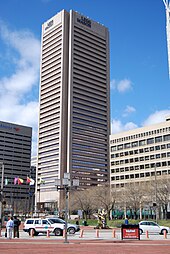
| Rank | Building | Height | Floors | Built | |
|---|---|---|---|---|---|
| 1 | Transamerica Tower(formerly the Legg Mason Building)[35] | 529 feet (161 m) | 40 | 1973 | [36] |
| 2 | Bank of America Building | 509 feet (155 m) | 37 | 1924 | [37] |
| 3 | William Donald Schaefer Building | 493 feet (150 m) | 37 | 1992 | [38] |
| 4 | Commerce Place | 454 feet (138 m) | 31 | 1992 | [39] |
| 5 | 100 East Pratt Street | 418 feet (127 m) | 28 | 1992 | [40] |
| 6 | Baltimore World Trade Center | 405 feet (123 m) | 28 | 1977 | [41] |
| 7 | Tremont Plaza Hotel | 395 feet (120 m) | 37 | 1967 | [42] |
| 8 | Charles Towers South Apartments | 385 feet (117 m) | 30 | 1969 | [43] |
| 9 | Blaustein Building | 360 feet (110 m) | 30 | 1962 | [44] |
| 10 | 250 West Pratt Street | 360 feet (110 m) | 24 | 1986 | [45] |
Neighborhoods[change|change source]
Baltimore is officially split into nine regions. These regions are based ongeography.Each region ispatrolledby their ownBaltimore Police Departmentdistrict. These regions are: Northern, Northwestern, Northeastern, Western, Central, Eastern, Southern, Southwestern, and Southeastern. Locals sometimes split the city into "East Baltimore" and "West Baltimore" alongCharles Street.Other locals sometimes split the city into "North Baltimore" and "South Baltimore" alongBaltimore Street.
TheCentral districtincludesDowntown Baltimore,Harborplace,The Camden Yards Sports Complex (Oriole Park at Camden YardsandM&T Bank Stadium), theConvention Center,and theNational Aquarium in Baltimore.It is the city's main commercial area. It also has manynightclubs,bars,restaurants,shopping centers, and other attractions. Many of the city's key businesses are in this area as well. TheUniversity of Maryland, Baltimorecampus,University of Maryland Medical System,Maryland Institute College of Art,thePeabody Instituteof music, theLyric Opera House,TheWalters Art Museum,and TheJoseph Meyerhoff Symphony Hallare also in the central district.
TheNorthern Districtis north of the Central district.Loyola University Maryland,The Johns Hopkins UniversityandCollege of Notre Dame of Marylandare in this district. Some of the richer residential neighborhoods are also here. The neighborhood ofRoland Park,the first planned suburban community in America, is one of these richer neighborhoods. The borders of the district are made byThe Alamedaon the east andPimlico Roadon the west.
TheSouthern districtis the part of the city below the Inner Harbor and east of theB&O Railroadtracks. It is a mix of industrial and residential areas. It is also a mix of manydemographics,cultures,andethnicities.It is home to the ethnically diverse neighborhood ofLocust Point,[46]the historic neighborhoodFederal Hill,[47]and poor residential neighborhoods likeCherry Hill.[48]There are twoPort of Baltimoreterminals in this district. The oldDomino Sugarplant is also here.[46]
TheNortheastern districtis mostly residential. It is home toMorgan State University.Today it is mostly African-American.[49][50][51]The district is bordered by the city line to the north and east;Sinclair Lane,Erdman Avenue,andPulaski Highwayon the south; and The Alameda on the west.
TheEastern districtis mostly poor, African-American residential neighborhoods. There are entire blocks of abandoned buildings. The district is also dangerous and has a problem withdrug trafficking.For this reason, the TV showThe Wirewas often filmed in this district.[52]This area is also home toJohns Hopkins HospitalandJohns Hopkins University School of Medicine.The district is bordered by Erdman Avenue, Sinclair Lane, andOrleans Street.
TheSoutheastern districtis a mix of industrial and residential areas. Neighborhoods in this district usually have a mix ofracesandcultures.[53][54][55][56]The district is bordered by Orleans Street, the Inner Harbor, the city line, and the Baltimore harbor.
TheNorthwestern districtis mostly residential. It is also home to thePimlico Race CourseandSinai Hospital.Until the 1960s, Baltimore'sJewishcommunity was based in thePark Heightsneighborhood. Since then, there has been "white flight"and the neighborhood today is almost all black.[57][58]Northern Parkwayis a dividing line in the district. North of the parkway, the neighborhoods are mostly white. Some of these areMount WashingtonandCheswolde.South of the parkway, the neighborhoods are mostly black.[59]The borders of the district are made up by the county line on the north and west,Gwynns Falls Parkwayon the south andPimlico Roadon the east.
TheWestern districtis the home ofCoppin State University,Mondawmin Mall,andEdmondson Village.These are important to the culture, economy and history of the city'sAfrican Americancommunity. This district used to be the home to many middle and upper class African Americans, but they have moved away since.[60]Today, more than 45% of people living in some neighborhoods have income levels below the poverty line.[61][62]Some of the crime from this district was used in the TV showThe Wire.The district is west of downtown. Its borders areGwynns Falls Parkway,Fremont Avenue,andBaltimore Street.
TheSouthwestern districtis a mix of industrial parks and residential areas.St. Agnes Hospitalis in this district. It has Baltimore County to the west, Baltimore Street to the north, and the downtown area to the east.
Neighboring communities[change|change source]
The City of Baltimore is next to several communities. All of these are unincorporatedcensus-designated places.
Culture[change|change source]
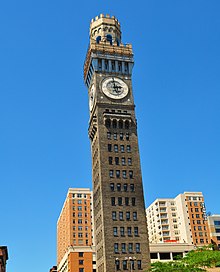
Baltimore is sometimes called the "city of neighborhoods." This name comes from the fact that it has 72 official historic districts (areas).[63]People of oneethnic groupmainly live in each one of these areas. Some of the most important today are downtown. These are theInner Harbor,Fells Point,andLittle Italy.The Inner Harbor has lots of hotels, shops, and museums. Many tourists visit the Inner Harbor. Fells Point used to be a place wheresailorswent forentertainment.Today it has been rebuilt and cleaned up. This is the neighborhood in the movieSleepless in Seattle.Little Italy is where theItalian-Americanpeople live and work.Nancy Pelosigrew up in this neighborhood. She used to beSpeaker of the HouseinCongress.
Another important neighborhood isMount Vernon.This neighborhood is the center of culture andartin Baltimore. There are many importantmonumentsandmuseumsthere. One important monument is theWashington Monument.This monument was built in the 1800s in aplaza.It is older than theWashington MonumentinWashington, D.C..
Every year there is an artfestivalcalledArtscape.The festival is in theBolton Hillneighborhood. This is very close to theMaryland Institute College of Art.Artscape is called the "largest free arts festival in America."[64]Another art festival that happens in Baltmore is theMaryland Film Festival.It happens every year in May. At the Film Festival,moviesare shown at theCharles Theatre.(The Charles Theatre is an oldcinema.)
One of Baltimore'snicknamesis "Charm City." Someadvertiserswanted to make the city'sreputationbetter. They started using the name in 1975.[65][66]
Language[change|change source]
People in Baltimore speak English. They have a very unique accent and way of speaking (dialect). For example, they pronounce "Baltimore" as "Balamer" or "Balmer." TheBaltimore dialectis sometimes called "Baltimorese." It is a kind of Mid-Atlantic English. People from Baltimore will often call each other "Hon."[67]
There aremoviesthatparody(make fun of) the way people from Baltimore talk. A lot of these movies are made byJohn Waters.He is a movie maker from Baltimore. Most of Waters's movies were made in Baltimore.Pink FlamingosandHairsprayare some of these movies. Waters also wrote themusicalversion ofHairspray.
Important people[change|change source]
Many very famous and important people were born or raised in Baltimore. Some of these are:
- Spiro Agnew(1918-1996), the 39thVice President of the United States
- Tori Amos(1963-, grew up in Baltimore), asinger,songwriter,andpianist
- Carmelo Anthony(1985-, grew up in Baltimore), aprofessionalbasketballplayer for theNew York Knicks
- John Astin(1930-),actorwho playedGomez AddamsonThe Addams Familytelevisionseries
- Eubie Blake(1883-1983), pianist andcomposerofragtimeandjazz
- Cab Calloway(1907–1994), jazzsingerandbandleader,raised in Baltimore
- Samuel Chase(1741–1811), a signer of theDeclaration of IndependenceandUS Supreme Courtjudge
- Tom Clancy(1947-2013), author ofThe Hunt for Red October
- Kevin Clash(1960-),puppeteerbest known forElmoonSesame Street
- Frederick Douglass(1818–1895),abolitionist,public figure,orator(speaker),editorandauthor
- Kevin Durant(1988-),NBAbasketball player forOklahoma City Thunder
- Philip Glass(1937-),minimalistcomposer
- Dashiell Hammett(1894–1961),detective,writer ofMaltese Falcon,born in Maryland and worked as a detective in Baltimore
- David Hasselhoff(1952-),actor
- Billie Holiday(1915–1959), jazz singer
- Stacy Keibler(1979-),actress,formerprofessional wrestler
- Thurgood Marshall(1908–1993), first African American US Supreme Court Justice
- Jim McKay(1921–2008), television sportsjournalist
- Ogden Nash(1902–1971),poet
- Edward Norton,(1969-), actor inFight Club,The Italian Job,andThe Incredible Hulk
- Nancy Pelosi(1940-),U.S. RepresentativefromCalifornia& formerSpeaker of the Houseof theUS House of Representatives
- Michael Phelps(1985-),Olympicswimmer,multiple world-record holder, winner of more gold medals (18) and total medals (22) than any other Olympian
- Edgar Allan Poe(1809–1849), poet, short story writer, editor and critic
- Parker Posey(1968-),actress,known forDazed and Confused,Waiting for Guffman,Scream 3,andBest in Show
- John Rawls(1921–2002), politicalphilosopher
- Cal Ripken, Jr.(1960-), formershortstopandthird basemanfor theBaltimore Orioles,member of theBaseball Hall of Fame
- Axl Rotten(1971-), professional wrestler
- Babe Ruth(George Herman Ruth) (1895–1948), professional baseball player for theBoston Red Sox,New York YankeesandBoston Braves,member of theBaseball Hall of Fame
- Pat Sajak(1946-), host of 'Wheel of Fortune'
- Dwight Schultz(1947-), actor onThe A-Team(H.M. Murdock) andStar Trek: The Next Generation(Lt. Reginald Barclay)
- Upton Sinclair(1878-1968), authorThe Jungleand winner of thePulitzer Prize
- John Waters(1946-), filmmaker
- George Whipple(1878–1976), winner of the 1934Nobel Prize in Medicine
- Montel Williams(1956-), television talk-show host
- Frank Zappa(1940–1993), singer,guitarist,composer andsatirist
Economy[change|change source]
Baltimore used to be mostlyindustrial.There was a lot ofsteelprocessing,shipping,carmanufacturing, andtransportation.Deindustrializationhappened, and Baltimore lost a lot of jobs that paid a lot of money and did not need a lot of training or skill.[68]Today, most of the jobs in Baltimore areservice economyjobs. These jobs do not pay very much. 90% of jobs are service jobs today.[69][70]
In July 2012, the unemployment rate was 11%.[71]Also in 2012, the steel mill (factory) at Sparrow's Point closed. This will mean more people will lose their jobs.[72]25% of people who live in Baltimore, and 37% of all children living in Baltimore, live inpoverty.[73]
Johns Hopkins Hospitalis in Baltimore. Some big companies from Baltimore areUnder Armour,[74]Cordish Company,[75]andRoyal Farms.[76]There is a bigsugar refineryin Baltimore. It is owned byAmerican Sugar Refining.
Transportation[change|change source]

There are eightInterstate Highwaysin Baltimore. These are:
- I-70
- I-83(theJones Falls Expressway)
- I-95(theJohn F. Kennedy Memorial Highway)
- I-395
- I-695(the Baltimore Beltway)
- I-795(the Northwest Expressway)
- I-895(the Harbor Tunnel Thruway)
- I-97
Some of these highways do not connect to each other. I-70 stops at a parking lot just inside of the city. This is because of "freeway revolts"that happened in Baltimore. The interstate highways were supposed to go through downtown Baltimore, but the people in the city did not want this to happen.Barbara Mikulski,now aUnited States Senator,started the "freeway revolts" to keep the highways from being built in downtown.
Today there are some highwaysnumbered U.S. highwaysand state routes that run through downtown. These areUS 1,US 40National Road,and theBaltimore-Washington Parkway.There are also sometunnelsunderneath theBaltimore harbor.I-95runs through theFort McHenry Tunnel.I-895runs through theHarbor Tunnel.
Baltimore has abeltway.A beltway is a highway thatcirclesaround a city. The Baltimore Beltway isI-695.It crosses over theChesapeake Bayon theFrancis Scott Key Bridge.Thisbridgeis justsouthof the Inner Harbor.
Baltimore is an importanttrainstop.Amtraktrains in theNortheast Corridorstop in Baltimore.Penn Stationis one of the busiesttrain stationsin the country. In 2008 it was the 8th busiest train station in the United States. That year, more than 1 million people took a train to or from Penn Station.[77]Another important train station is atBaltimore-Washington International Thurgood Marshall Airport.Many Amtrak trains stop at theBWI Rail Station.The Amtrak trains that stop in Baltimore are:Acela Express,Palmetto,Carolinian,Silver Star,Silver Meteor,Vermonter,Crescent,andNortheast Regional.TheMARC commuter rail servicealso has trains that stop in Baltimore. The MARC trains run fromCamden Stationand Penn Station in Baltimore toUnion StationinWashington, D.C..
Education[change|change source]
Colleges and universities[change|change source]
Baltimore has manycollegesanduniversities.These are both public (run by thegovernment) and private. Some of them are:
Private[change|change source]
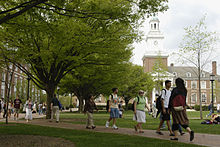
- Baltimore International College(BIC)
- The Johns Hopkins University(JHU)
- Loyola University Maryland(LUM)
- Maryland Institute College of Art(MICA)
- Notre Dame of Maryland University(NDM)
- Peabody Instituteof the Johns Hopkins University
- Sojourner-Douglass College
Public[change|change source]
- Baltimore City Community College(BCCC)
- Coppin State University(CSU)
- Morgan State University(MSU)
- University of Baltimore(UB)
- University of Maryland, Baltimore(UMB, formerly UMAB)
Primary and secondary schools[change|change source]
Baltimore City Public School Systemruns Baltimore'spublic schools.Some of these schools are well known.Carver Vocational-Technical High Schoolwas the firstvocationalhigh school for African-Americans in Maryland.Lake Clifton Eastern High Schoolis the biggest school campus in Baltimore City.Frederick Douglass High Schoolis the second-oldest African-American high school in the United States.[78]Baltimore City Collegeis the third oldest public high school in the country.[79]Western High Schoolis the oldest public all-girls school in the nation.[80]Baltimore City College andBaltimore Polytechnic Institutearefootball rivals.This is the second-oldest high school football rivalry in the country.[81]
Media[change|change source]
Baltimore's mainnewspaperisThe Baltimore Sun.In 1986, the newspaper was sold to theTimes Mirror Company.[82]This company was bought by theTribune Companyin 2000.[83]Today,The Sunis still a Tribune newspaper.
Baltimore had two newspapers until 1986. (It was very common for US cities to have two newspapers.) The other main newspaper was theBaltimore News-American.TheNews-Americanwent out of business in 1986.[84]
The Baltimore Examinerwas started in 2006 to compete withThe Sun.It was owned and run by a company that also published newspapers likeThe San Francisco ExaminerandThe Washington Examiner.The Examinerwas a free newspaper that was paid for byadvertising.(The Sunis not free.)The Examinerwas not able to make money, and it stopped being published on February 15, 2009.
According toNielsen Market Research,Baltimore had the 26th-largesttelevision marketin 2008-2009. It was the 27th-largest market for 2009-2010.[85]Arbitronlisted Baltimore as the 22nd-largestradio marketin Fall 2010.[86]
Sports teams[change|change source]

Baseball[change|change source]
Baltimore has a longbaseballhistory. The first team to play for Baltimore were the19th century Baltimore Orioles(1882-1899). This was one of the most successful early baseball teams. The team had manyhall of famersplay for them. The greatBabe Ruthwas born in Baltimore in 1895. He played for theminor league Baltimore Oriolesteam. This team existed from 1903 to 1914 and from 1916 to 1953.[87]
Today, Baltimore'sMajor League Baseballteam is theBaltimore Orioles.They play in theAmerican League.The Orioles came to Baltimore in 1954. Before that, the team had been inSt. Louis, Missouri,where they were called theSt. Louis Browns.The Orioles went to theWorld Seriesin 1966, 1969, 1970, 1971, 1979 and 1983. They won the World Series three times: in 1966, 1960, and 1983.
In 1995,Cal Ripken, Jr.broke the record for the most games played in a row. The old record was set byLou Gehrig,and was 2,130 games. Ripken was added to theBaseball Hall of Fame.He was also named "Sportsman of the Year"bySports Illustratedmagazine. There are six Orioles players and two managers in the hall of fame.
Football[change|change source]
Baltimore's firstfootballteam were theBaltimore Colts.The team came to Baltimore in 1953. Before then, they had played inDallas, Texasas theDallas Texans.The Colts played for Baltimore until 1984. In 1984, the team moved toIndianapolisand took the name. Today the team still plays as theIndianapolis Colts.
In 1996, theCleveland Brownscame to Baltimore. They were renamed theBaltimore Ravens.The Ravens won aSuper Bowlchampionship in 2000 and again in 2012. They also won threeAmerican Football Conference(AFC)Northdivision championships in 2003, 2006, and 2011. In addition, the played in threeAFC Championship Gamesin 2000, 2009, and 2011.
Other teams and events[change|change source]
Baltimore has an indoor soccer team, theBaltimore Blast.They play for theMajor Indoor Soccer Leagueat the1st Mariner Arena.The team joined the League in 2001. The Blast have won 5 league championships: 2002, 2003, 2005, 2007 and 2008.
TheBaltimore Bluesare a semi-professionalrugby league footballclub. They will compete in theUSA Rugby Leaguein 2012.[88]Other professional or semi-professional Baltimore teams includeCrystal Palace Baltimore,an outdoor soccer franchise of USL Second Division.TheCharm City Roller Girlsare a member of theWomen's Flat Track Derby Associationsince 2005.
ThePreakness Stakesare held every May at thePimlico Race Coursein Baltimore. The Preakness is the "second jewel" in theUnited States Triple Crown of Thoroughbred Racing.
Car races are held on the streets of downtown every year in September. TheBaltimore Grand Prixruns through the Inner Harbor. It started in 2011. TheAmerican Le Mans Series,IndyCar Series,Indy Lights,and other races are a part of it.
Politics[change|change source]
Baltimore is very politically liberal. The mayor of Baltimore is aDemocrat.84.7% of the voters in 2016 voted for the DemocratHillary Clinton,and 87.2% of the voters in 2012 voted for the DemocratBarack Obama.The last time a Republican running for president won more votes than the Democratic candidate in Baltimore was 1956. Even in 1984, whenRonald Reaganwon 49 states in his reelction campaign, only 28.2% of the voters in Baltimore voted for him.
Sister cities[change|change source]
Baltimore has elevensister cities.These were picked bySister Cities International.[89][90]
|
References[change|change source]
- ↑1.01.11.2Donovan, Doug (May 20, 2006)."Baltimore's New Bait: The City is About to Unveil a New Slogan, 'Get In On It,' Meant to Intrigue Visitors".The Baltimore Sun.RetrievedNovember 28,2008– via RedOrbit.
- ↑Kane, Gregory(June 15, 2009)."Dispatch from Bodymore, Murderland".The Washington Examiner.
- ↑Cutler, Josh S. (February 18, 2019).Mobtown Massacre: Alexander Hanson and the Baltimore Newspaper War of 1812.ISBN9781439666203.
- ↑Gettleman, Jeffrey(September 2, 2003)."In Baltimore, Slogan Collides with Reality".The New York Times.
- ↑"2020 U.S. Gazetteer Files".United States Census Bureau.RetrievedMay 6,2024.
- ↑"Highest and Lowest Elevations in Maryland's Counties".Maryland Geological Survey.Maryland Department of Natural Resources. Baltimore City.Archivedfrom the original on October 5, 2007.RetrievedNovember 14,2007.
- ↑7.07.1"QuickFacts: Baltimore city, Maryland".United States Census Bureau.RetrievedJanuary 3,2024.
- ↑"2020 Population and Housing State Data".United States Census Bureau.Retrieved22 August2021.
- ↑"ZIP Code Lookup".USPS. Archived fromthe originalon November 23, 2010.RetrievedOctober 13,2014.
- ↑Krugler, John D (2004).English and Catholic: the Lords Baltimore in the Seventeenth Century.Baltimore: Johns Hopkins University Press. p. 74.ISBN0801879639.
- ↑Hezekiah Niles (1876).Principles and Acts of the Revolution in America.New York: A. S. Barnes & Co. pp. 257–258.
- ↑"Henry Fite's House, Baltimore".U.S. Department of State, Office of the Historian.Retrieved2011-03-23.
- ↑"Baltimore, Maryland—Government".Maryland Manual On-Line: A Guide to Maryland Government.Maryland State Archives. October 23, 2008. Archived fromthe originalon 2008-09-19.Retrieved2008-10-27.
- ↑"The Great Strike".Catskill Archive.Timothy J. Mallery.Retrieved2008-10-26.
- ↑"Baltimore, October 17".Salem Gazette.Salem,Massachusetts. October 23, 1827. p. 2.Retrieved2008-10-27.
- ↑"The Baltimore Bank Riot".University of Illinois Press.Retrieved2010-01-05.
- ↑Scharf, J. Thomas (1967).History of Maryland From the Earliest Period to the Present Day.Vol. 3 (2nd ed.). Hatboro, PA: Tradition Press. pp. 733–42.
- ↑"A Howling Inferno: The Great Baltimore Fire".Virtually Live@Hopkins.Johns Hopkins University. January 12, 2004. Archived fromthe originalon 2011-07-19.Retrieved2011-03-17.
- ↑Peter B. Petersen (2009)."Legacy of the Fire".Fire Museum of Maryland. Archived fromthe originalon 2011-10-03.Retrieved2011-03-18.
- ↑George P. Bagby, ed. (1918).The annotated code of the public civil laws of Maryland, Volume 4.King Bros., Printers and Publishers. p. 769.
- ↑Duffy, James (December 2007). "Baltimore seals its borders".Baltimore Magazine.pp. 124–27.
- ↑Short, John R (2006).Alabaster cities: urban U.S. since 1950.Syracuse University Press. p. 142.ISBN0-8156-3105-7.
- ↑"Baltimore '68 Events Timeline".Baltimore 68: riots and Rebirth.University of Baltimore Archives.Retrieved2011-01-19.
- ↑"Recalling Baltimore's 1968 riots".The Baltimore Sun.April 3, 1998.Retrieved2011-01-19.
- ↑"Who We Are".Maryland Stadium Authority.Retrieved2008-10-26.
- ↑"Highest and Lowest Elevations in Maryland's Counties".Maryland Geological Survey.Archived fromthe originalon 2014-01-03.Retrieved2007-11-14.
- ↑27.027.1"Average Monthly High and Low Temperatures for Baltimore, MD (21211)".The Weather Channel.Archived fromthe originalon 2008-01-21.Retrieved2007-10-21.
- ↑NOAA, "1981-2010 Climate averages"(PDF).
- ↑ "The New 1981-2010 Climate Normals"(PDF).National Oceanic and Atmospheric Administration.August 2011.Retrieved2011-08-08.
- ↑"Climatological Normals of Baltimore".Hong Kong Observatory.Archived fromthe originalon 2012-04-19.Retrieved2010-06-14.
- ↑ "Average Temperatures for Baltimore, MD (Inner Harbor)".NOAA.Retrieved2010-11-22.
- ↑ "Climatological Data for Baltimore, MD (Inner Harbor)".NOAA.Retrieved2010-11-22.
- ↑Evitts, Elizabeth (April 2003)."Window to the Future"(PDF).Baltimore Magazine.Archived fromthe original(PDF)on September 11, 2011.RetrievedMay 6,2009.
- ↑Bishop, Tricia (April 7, 2003)."Illuminated by a jewel".The Baltimore Sun.Archived fromthe originalon May 24, 2011.RetrievedMay 6,2009.
- ↑Hopkins, Jamie Smith (October 31, 2011)."Transamerica workers begin move to downtown skyscraper".The Baltimore Sun.RetrievedNovember 16,2011.
- ↑"Legg Mason Building".Emporis Corporation.RetrievedNovember 1,2007.
- ↑"Bank of America Building".Emporis Corporation.RetrievedNovember 1,2007.
- ↑"William Donald Schaefer Tower".Emporis Corporation.RetrievedNovember 1,2007.
- ↑"Commerce Place".Emporis Corporation.RetrievedNovember 1,2007.
- ↑"100 East Pratt Street".Emporis Corporation.RetrievedNovember 1,2007.
- ↑"Trade Center".Emporis Corporation.RetrievedNovember 1,2007.
- ↑"Tremont Plaza Hotel".Emporis Corporation.RetrievedNovember 1,2007.
- ↑"Charles Towers South Apartments".Emporis Corporation.RetrievedNovember 1,2007.
- ↑"Blaustein Building".Emporis Corporation.RetrievedNovember 1,2007.
- ↑"250 West Pratt Street".Emporis Corporation.RetrievedNovember 1,2007.
- ↑46.046.1Scott Sheads."Locust Point – Celebrating 300 Years of a Historic Community".Locust point Civic Association. Archived fromthe originalon September 29, 2007.RetrievedApril 1,2011.
- ↑"Discover Federal Hill".Historic Federal Hill.Archived fromthe originalon March 7, 2011.RetrievedApril 1,2011.
- ↑"History of Cherry Hill"(PDF).Cherry Hill Master Plan.Baltimore City Department of Planning. July 10, 2008. p. 10. Archived fromthe original(PDF)on September 12, 2011.RetrievedApril 1,2011.
- ↑"New Northwood neighborhood in Baltimore".City-Data.com.RetrievedMarch 29,2011.
- ↑"Profile of General Demographic Characteristics (2000): Hillen"(PDF).Baltimore City Planning Department. Archived fromthe original(PDF)on August 12, 2011.RetrievedMarch 29,2011.
- ↑"Profile of General Demographic Characteristics (2000): Stonewood-Pentwood-Winston"(PDF).Baltimore City Planning Department. Archived fromthe original(PDF)on August 12, 2011.RetrievedMarch 29,2011.
- ↑Gadi Dechter (May 24, 2006)."A Guided Tour Of The Wire's East Baltimore".Baltimore City Paper.RetrievedApril 1,2011.
- ↑"O'Donnell Heights neighborhood in Baltimore".City-Data.com.RetrievedApril 4,2011.
- ↑"Fells Point neighborhood in Baltimore, Maryland".City-Data.com.RetrievedApril 4,2011.
- ↑"Hopkins Bayview neighborhood in Baltimore".City-Data.com.RetrievedApril 4,2011.
- ↑"Greektown neighborhood in Baltimore, Maryland".City-Data.com.RetrievedApril 4,2011.
- ↑"Park Heights".Live in Baltimore.RetrievedApril 4,2011.
- ↑"Park Heights neighborhood in Baltimore, Maryland".City-Data.com.RetrievedApril 4,2011.
- ↑"West Arlington neighborhood in Baltimore, Maryland".City-Data.com.RetrievedApril 4,2011.
- ↑Theo Lippman, Jr. (September 19, 1990). "Remember When: The shorthand way to describe what was...".The Baltimore Sun.
- ↑"Upton neighborhood in Baltimore, Maryland".City-Data.com.RetrievedApril 5,2011.
- ↑"Poppleton neighborhood in Baltimore, Maryland".City-Data.com.RetrievedApril 5,2011.
- ↑"Baltimore City Residents".City of Baltimore, Maryland. Archived fromthe originalon June 21, 2009.RetrievedJune 5,2009.
- ↑Mike Unger."Artscape 2010 in Baltimore".About.com Baltimore.Archived fromthe originalon July 7, 2011.RetrievedMarch 15,2011.
- ↑Sandler, Gilbert (18 July 1995)."How the city's nickname came to be".Baltimore Sun.Retrieved1 August2012.
- ↑Sandler, Gil (18 August 1998)."Where did city get its charming nickname? Baltimore Glimpses".Baltimore Sun.Retrieved1 August2012.
- ↑"The Mid-Atlantic Dialects".Evolution Publishing. Archived fromthe originalon July 23, 2013.RetrievedMarch 29,2011.
- ↑Vicino, Thomas J. (2008).Transforming Race and Class in Suburbia: Decline in Metropolitan Baltimore.New York: Palgrave Macmillan.ISBN9780230605459.
- ↑Moore, Robert (2004). "A Brief Economic History of Modern Baltimore".Putting Baltimore's People First Keys to Responsible Economic Development of Our City.District 1199E-DC, SEIU, AFL–CIO. Archived fromthe originalon 24 January 2013.Retrieved7 October2012.
- ↑Hopkins, Jamie Smith (26 April 2012)."'Next economy' envisioned for Baltimore region: Brookings study calls on leaders to reshape economy, reverse low-wage trend ".Baltimore Sun.Archived fromthe originalon 5 June 2013.Retrieved7 October2012.
- ↑Haber, Gary (24 September 2012)."Rawlings-Blake talks Baltimore's jobs effort".Baltmore Business Journal.Retrieved7 October2012.
- ↑Shen, Fern (20 August 2012)."Baltimore steelworkers brace for unemployment:" It's rough out there "Men and women schooled in steelmaking reflect on their future".Baltimore Brew.Retrieved7 October2012.
- ↑Kilar, Steve (20 September 2012)."Baltimore's poverty rate unchanged at 1 in 4 residents: More young Marylanders insured following healthcare overhaul".Baltimore Sun.Archived fromthe originalon 1 November 2012.Retrieved7 October2012.
- ↑Mirabella, Lorraine (14 October 2011)."Under Armour's growth worries some neighbors: Company plans to double size of Baltimore headquarters".Baltimore Sun.Retrieved5 October2012.
- ↑"Company Overview of The Cordish Company, Inc".Real Estate Management and Development.Business Week.Retrieved5 October2012.
- ↑"Best Convenience-Store Dining: Royal Farms".CityPaper.19 September 2001.Retrieved5 October2012.
- ↑"Amtrak Fact Sheet, Fiscal Year 2008: State of Maryland"(PDF).Amtrak. November 2008.RetrievedDecember 6,2009.
- ↑"Film shows Baltimore school struggling despite No Child Left Behind law".Associated Press. June 21, 2008.RetrievedJanuary 24,2009.
- ↑Katz-Stone, Adam (January 28, 2000)."School boundaries".Baltimore Business Journal.RetrievedJanuary 24,2009.
- ↑"WHS Flyer"(PDF).Western High School. Archived fromthe original(PDF)on February 5, 2009.RetrievedJanuary 24,2009.
- ↑Patterson, Ted (2000).Football in Baltimore: History and Memorabilia.Baltimore: Johns Hopkins University Press. p. 7.ISBN978-0-8018-6424-7.
- ↑"The Times Mirror Company—Company History".fundinguniverse.com.Funding Universe.Retrieved2008-11-25.
- ↑Smith, Terence(March 21, 2000)."Tribune Buys Times Mirror".pbs.org.MacNeil/Lehrer Productions. Archived fromthe originalon 2008-09-07.Retrieved2008-11-25.
- ↑"The Baltimore News American Photograph Collection".University of Maryland: Libraries. December 18, 2009. Archived fromthe originalon 2010-04-30.Retrieved2009-12-31.
- ↑"Local Television Market Universe Estimates"(PDF).nielsen. Archived fromthe original(PDF)on 2011-03-17.Retrieved2011-03-16.
- ↑"Arbitron Radio Market Rankings: Fall 2010".Arbitron.Retrieved2011-03-16.
- ↑"Baltimore Orioles (minors)".Baseball-Reference.com.Sports Reference, LLC.RetrievedApril 5,2011.
- ↑"USARL | USA Rugby League | American Rugby League « Uncategorized « USARL welcome the Blues!".USA Rugby League. December 12, 2011. Archived fromthe originalon January 9, 2012.RetrievedJanuary 8,2012.
- ↑"Sister Cities".Visit Baltimore.Archived fromthe originalon October 11, 2011.RetrievedMarch 30,2011.
- ↑"Sister City Committee".Baltimore-Luxor-Alexandria Sister City Committee.RetrievedMarch 30,2011.

